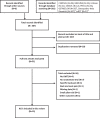Osteopathic manipulative treatment for nonspecific low back pain: a systematic review and meta-analysis
- PMID: 25175885
- PMCID: PMC4159549
- DOI: 10.1186/1471-2474-15-286
Osteopathic manipulative treatment for nonspecific low back pain: a systematic review and meta-analysis
Abstract
Background: Nonspecific back pain is common, disabling, and costly. Therefore, we assessed effectiveness of osteopathic manipulative treatment (OMT) in the management of nonspecific low back pain (LBP) regarding pain and functional status.
Methods: A systematic literature search unrestricted by language was performed in October 2013 in electronic and ongoing trials databases. Searches of reference lists and personal communications identified additional studies. Only randomized clinical trials were included; specific back pain or single treatment techniques studies were excluded. Outcomes were pain and functional status. Studies were independently reviewed using a standardized form. The mean difference (MD) or standard mean difference (SMD) with 95% confidence intervals (CIs) and overall effect size were calculated at 3 months posttreatment. GRADE was used to assess quality of evidence.
Results: We identified 307 studies. Thirty-one were evaluated and 16 excluded. Of the 15 studies reviewed, 10 investigated effectiveness of OMT for nonspecific LBP, 3 effect of OMT for LBP in pregnant women, and 2 effect of OMT for LBP in postpartum women. Twelve had a low risk of bias. Moderate-quality evidence suggested OMT had a significant effect on pain relief (MD, -12.91; 95% CI, -20.00 to -5.82) and functional status (SMD, -0.36; 95% CI, -0.58 to -0.14) in acute and chronic nonspecific LBP. In chronic nonspecific LBP, moderate-quality evidence suggested a significant difference in favour of OMT regarding pain (MD, -14.93; 95% CI, -25.18 to -4.68) and functional status (SMD, -0.32; 95% CI, -0.58 to -0.07). For nonspecific LBP in pregnancy, low-quality evidence suggested a significant difference in favour of OMT for pain (MD, -23.01; 95% CI, -44.13 to -1.88) and functional status (SMD, -0.80; 95% CI, -1.36 to -0.23), whereas moderate-quality evidence suggested a significant difference in favour of OMT for pain (MD, -41.85; 95% CI, -49.43 to -34.27) and functional status (SMD, -1.78; 95% CI, -2.21 to -1.35) in nonspecific LBP postpartum.
Conclusion: Clinically relevant effects of OMT were found for reducing pain and improving functional status in patients with acute and chronic nonspecific LBP and for LBP in pregnant and postpartum women at 3 months posttreatment. However, larger, high-quality randomized controlled trials with robust comparison groups are recommended.
Figures









References
-
- van Tulder M, Becker A, Bekkering T, Breen A, del Real MT, Hutchinson A, Koes B, Laerum E, Malmivaara A, Care CBWGoGftMoALBPiP Chapter 3. European guidelines for the management of acute nonspecific low back pain in primary care. Eur Spine J. 2006;15(Suppl 2):S169–S191. doi: 10.1007/s00586-006-1071-2. - DOI - PMC - PubMed
-
- Airaksinen O, Brox JI, Cedraschi C, Hildebrandt J, Klaber-Moffett J, Kovacs F, Mannion AF, Reis S, Staal JB, Ursin H, Zanoli G. Chapter 4. European guidelines for the management of chronic nonspecific low back pain. Eur Spine J. 2006;15(Suppl 2):S192–S300. doi: 10.1007/s00586-006-1072-1. - DOI - PMC - PubMed
-
- National Collaborating Centre for Primary Care . Low Back Pain: Early Management of Persistent Non-specific Low Back Pain. NICE Clinical Guideline 88. London: National Institute for Health and Clinical Excellence; 2009.
Pre-publication history
-
- The pre-publication history for this paper can be accessed here:http://www.biomedcentral.com/1471-2474/15/286/prepub
Publication types
MeSH terms
LinkOut - more resources
Full Text Sources
Other Literature Sources
Medical
Miscellaneous

